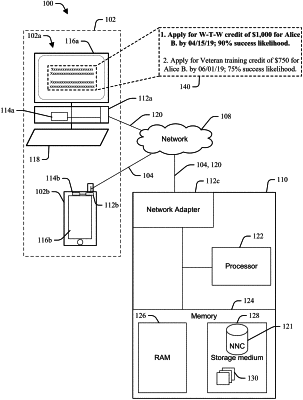| CPC G06Q 40/123 (2013.12) [G06N 3/08 (2013.01); G06Q 10/105 (2013.01)] | 19 Claims |

|
1. A computer-implemented method, comprising:
integrating computer-readable program code into a computer system comprising a processor, a computer readable memory in circuit communication with the processor, and a computer readable storage medium in circuit communication with the processor;
the processor executing program code instructions stored on the computer-readable storage medium via the computer readable memory and thereby performing steps of:
extracting, from payroll data of each of plurality of employees of an organization, data that is historically associated to previous instances of certified tax credit eligibility;
normalizing the extracted data with respect to data type and data value;
generating, via a neural network classifier, from an input of the normalized extracted data, multi-class outputs for each employee that indicate strengths of likelihood that each employee is currently eligible for each of a plurality of different tax credits, wherein the neural network classifier is trained on normalized data values and historic success rates for each of a plurality of persons that applied for the tax credits;
filtering the normalized extracted data by removing portions of the normalized extracted data that are associated to ones of the employees that are indicated within the multi-class outputs as having no likelihood that they are currently eligible for any of the plurality of different tax credits, thereby generating a remainder set of normalized extracted data that is associated to the remainder eligible ones of the employees; and
prioritizing an order of application for each of the tax credits for the remainder eligible ones of the employees as a function of respective values and likelihoods of eligibility of the tax credits indicated within the remainder set of normalized extracted data.
|